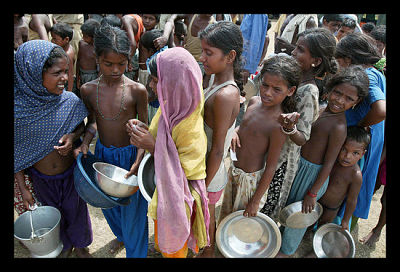Malnutrition in India – An Unspoken Diagnosis

Health reporter Harman Boparai recently travelled to India where he once practiced as a physician to learn more about child health in the country. In the pediatric ward at Panna District Hospital, Bopari reported that the children, who suffered from different illnesses and came from different villages, were all extremely undernourished. Nutrition has increasingly been recognized as a basic but crucial contributor for social and economic development.
According to the World Health Organization, 165 million children under 5 years of age suffered from stunted growth in 2011.This means that one in four of the world’s children did not get the right nutrients or food to grow. Of the total number of malnourished children in the world, one in every three lives in India. Adequate nutrition is essential in early childhood to ensure healthy growth, a strong immune system, proper organ formation and function, and neurological and cognitive development.
Economic growth and development also require well-nourished populations who have the capablity to learn new skills, think critically, and contribute to their communities. Boparai later traveled to New Delhi where he talked with individuals working on the issues. At Save the Children India, Shireen Miller, the nonprofit’s director for advocacy, explained that the implementation of government food security programs was essential to the survival of children in the country. “Malnutrition is a critical factor in child survival,” she said. “When we say that a child dies of illnesses like diarrhea and pneumonia, it is because of the fact that they’re malnourished which has reduced their ability to withstand that illness.”
According to UNICEF, in India, around 46 percent of all children under 3 are too small for their age, and 47 percent are underweight. The severity of the issue of malnutrition varies across states, with Kerala among the lowest rates at 27 percent, and Madhya Pradesh at the highest rate of 55 percent. To reverse the current trend, the Government of India started a program under the Integrated Child Development Services (ICDS), which works to provide poor Indian children with the nutrients needed to grow and end malnutrition in India. The program not only provides immunization and supplementary nutrition, but also educates pregnant women and mothers of young children on health and nutrition.
ICDS in India is the world’s largest integrated early childhood program, with over 40,000 offices nationwide. The program today covers over 4.8 million expectant and nursing mothers and over 23 million children under the age of six. Of these children, approximately half participate in early learning activities. Across the developing world, 66 million children go to primary school hungry. This lack of nutrition means these children are less likely to perform at their full potential in school. The World Food Programme estimates that $3.2 billion is needed annually to reach all 66 million hungry school-aged children, or less than 0.2 percent of the world’s military spending.
– Ali Warlich
Sources: Global Post, WHO, UNICEF, Global Issues
